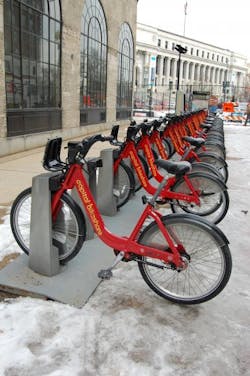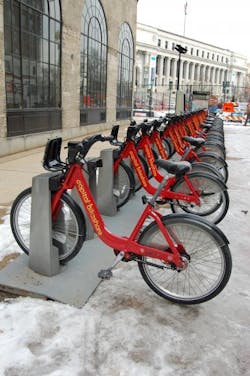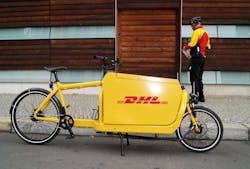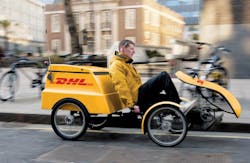It’s more than little interesting to hear that the trusty bicycle – designs for which by some accounts first emerged back way back in 1493, a year after Christopher Columbus “discovered” America – is coming back in vogue as a means of not only for daily passenger transit but freight carriage as well.
The more things change …
Anyways, I listened to an interesting presentation extoling the bike this week at annual “Washington Briefing” hosted by the American Association of State Highway and Transportation Officials (AASHTO) by Jim Sebastian, supervisory transportation planner for the District of Columbia’s Department of Transportation.Sebastian discussed the Capital Bikeshare program – started in Washington D.C. nearly five years ago and now including several nearby counties as well – explaining that the entity’s nearly 3,000 “tank-tough” bikes, 348 solar-powered “docking stations,” and 30,000 members have accumulated 9 million passenger trips since 2010.
Yet the most interesting part of this program is what he said is one of its guiding principles: “To complement other transportation modes.”
In Sebastian’s view, as modern societies begin to “re-urbanize,” he and other planners think the plain-old bike can play a more practical role in augmenting mass transit systems, providing a lower cost “public” transport option for city dwellers – as well as one that obviously offers some health benefits, too.
OK, you ask, so what does any of this have to do with freight?
Well, for starters, Sebastian said one of the “next steps” being contemplated by the Capital Bikeshare program is to offer cargo-carrying capable bikes within its network. Thus a local business could conceivably shift short-distance small parcel shipments over to bicycles.
It’s not as far-fetched as you may think, as several recent stories – go here and here for just two examples – tout the cargo-carrying potential for bicycles as the densities of cities around the world increase.
Then you have the bike tinkering being conducted by global logistics providers such as DHL.After conducting several pilot projects in various European countries, DHL began testing in Germany last year the use of bicycles for the express delivery of documents and smaller parcel items. In Berlin and Frankfurt, the company deployed two different bicycle models.
The first (seen at left) is dubbed the "DHL Parcycle," which has a sealable transport box with a holding capacity of 140 liters (what’s that in pounds? I just don’t know).
The second model is what’s described as a “more maneuverable” DHL Touring Bike, primarily suited for use with a courier backpack. DHL added that its “bike delivery” tests will soon be expanded to two other major cities in northern and southern Germany.
"Using bicycles to make deliveries has made us significantly more flexible and faster in downtown areas and conurbations," noted Tobias Wider, member of the DHL Express Germany’s divisional board, in a statement. "Unlike delivery vehicle drivers, bicycle couriers can always drive right up to the recipient's door, are not affected by downtown traffic volumes or access restrictions and at times can even use shorter routes."In addition, bicycles allow DHL Express to meet the requests of many customers for a "cleaner transport alternative" that is environmentally friendly, he said.
"Our aim is to utilize bicycle couriers in the next few years anywhere they can improve our customer service and effectiveness," Wider added.
To date, DHL Express is using bicycle couriers in nine European countries so far – including the Netherlands, France, Great Britain and Italy – in about 40 cities total. Those two Germany-based pilot projects noted above are part of the company’s ongoing effort to improve the efficiency and cargo-carry-capacity of such “two wheeled transports.”
Proof that a new chapter regarding the freight-hauling potential of the tried-and-true bicycle may yet be written.



